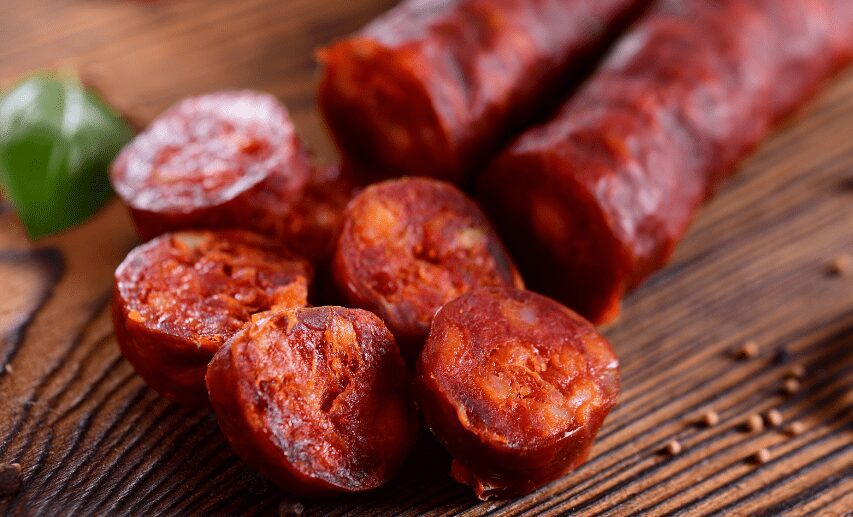
Every nation in the globe has a distinctive national sausage that is influenced by its particular indigenous components.
In the following list, you’ll find some of the most common varieties at markets and grocery shops, what to expect from each in terms of flavor, and some tips on how to best enjoy them:
Italian
Usually available in sweet, hot, and mild varieties, pork-based Italian sausage features flavors that immediately bring old-world spices to mind — basil, garlic, oregano, and most distinctively, fennel seed.
Sometimes referred to as “salsiccia,” Italian sausage makes a great addition to pasta sauces and rice dishes, or you can always crumble and brown the bulk meat to top your favorite pizza recipe.
Other entries in the Italian sausage category include cured salami, spicy soppressata, and bologna-like mortadella, all perfectly sliceable for sandwiches and snacks.
No products found.
Polish
Redolent of garlic and marjoram, traditional Polish sausage — aka kielbasa — must be made with cured pork (sometimes mixed with veal) to be considered an accurate, genuine article.
In Poland, diners can expect to find this sausage most commonly served hot dog-style on a bun complemented with onions and horseradish or plated on its own with tangy sauerkraut.
Wurst
Just walk past any Bavarian meat counter or butcher shop, and you’ll quickly find out that Germany is home to a dizzying family of sausage products,
from the familiar bratwurst, frankfurters, and garlicky knackwurst to fragrantly seasoned currywurst, veal-based weisswurst (white sausage) and rich blutwurst (blood sausage).
Like its Polish counterparts, German sausages often arrive at the table on a bun served with mustard or as an entrée with sauerkraut and some form of potato.
Chorizo
This heavily spiced pork-based sausage is prepared fresh or dry-cured, depending on which hemisphere you find it.
In Spain and Portugal, chorizo is dry-cured, often fermented, sometimes smoked, and usually seasoned with garlic, herbs, wine, and dulce (sweet) or Picante (spicy) smoked pimentón, which is similar to paprika.
A frequent option on tapas menus, these chorizos are also used to season traditional entrées such as paella, Caldo Verde, and Spanish tortillas, egg dishes similar to frittatas.
Latin America favors raw chorizo, sold with or without casings, usually prepared with local chiles and vinegar instead of wine.
Depending on the region where it’s made, flavorings may include cinnamon, clove, nutmeg, anise, cumin, and citrus.
Fresh chorizo is often cooked and crumbled to stuff inside corn tortillas and empanadas, sprinkled over melted queso and arepas, and to accent countless savory dishes.
Merguez
This North African recipe melds lamb and/or beef with aromatic seasonings like harissa, cumin, sumac, garlic, and chile peppers for a heady scent and characteristic red color.
Merguez is usually served broiled or grilled with rice and vegetables as traditional accompaniments. The sausage also has quite a following in France, typically presented with Dijon mustard, sliced baguette, and Pommes Frites.
- Eight 5 oz bags of Duke's Original Recipe Smoked Shorty Sausages Gluten Free Snack
- Delicious, authentic meat sticks made with real, whole ingredients and flavorful smoked meats
- Classic flavored dried sausage sticks with an authentic, old-world flavor that make for great gluten free snacks
- Dried meat snack made with a blend of classic spices, chopped green Italian parsley, a touch of roasted garlic, and fresh, never frozen pork
- Smoked sausage snack that has 7 g of protein per serving and are slow dried with no nitrites added
Saucisson
Thick, meaty saucisson is France’s more classic dry-cured sausage, heavy on garlic and herbs.
An approachable starter sausage for anyone new to charcuterie, simply sliced saucisson pairs ideally as is on a platter with a variety of cheeses, bread, grainy mustard, and cornichons.
Lap Cheong
Readily available in Asian markets and grocery stores, these Cantonese pork sausages can be steamed with rice or cooked quickly in a wok and are often part of Chinese New Year celebration menus.
Their distinctive taste stems from a combination of garlic, chile pepper, ginger, and the addition of MSG as a flavor enhancer.
Breakfast Sausage
Sometimes referred to as “country-style,” breakfast sausage is what many American diners count on as part of a hearty morning meal in link or patty form alongside pancakes and eggs or crumbled into the gravy and ladled over biscuits.
Usually spiced with sage and black pepper, this fresh pork sausage may also incorporate sweet brown sugar or maple syrup notes.
Boiled, broiled, or baked: 7 ways to prepare sausage
Andouille
Most people associate andouille with the Cajun and Creole cuisines of New Orleans, where it serves as a component of gumbo, jambalaya, and other regional Louisiana recipes.
Still, this smoked pork sausage originated in France. A melting pot of seasonings that includes thyme, bay leaf, paprika, and sage gives andouille its distinct flavor, with cayenne added for a spicy kick.
Summer Sausage
Akin to Italian salami, American summer sausage is dried or smoked to store at room temperature without refrigeration.
It’s usually made with pork, beef, venison, or a combination of meats and seasoned with curing salt, garlic, and mustard seeds.
Despite its seasonal name, summer sausage is often included in holiday gift boxes for recipients to enjoy with Cheddar cheese and crackers.
No products found.
Vegan Sausage
Thanks to innovative recipes and alternative ingredients, vegans no longer have to dismiss, ignore or mourn their cravings for smoky sausage.
Plant-based varieties rely on beans, nuts, mushrooms, oats, chickpeas, soy protein, and other meat-free building blocks to mimic the texture of traditional sausage with all the traditional seasonings.
Vegan sausage varieties can be used in the same ways and subbed in recipes for their meaty counterparts, often without any discernable difference in flavor.
Last update on 2024-11-21 / Affiliate links / Images from Amazon Product Advertising API


































